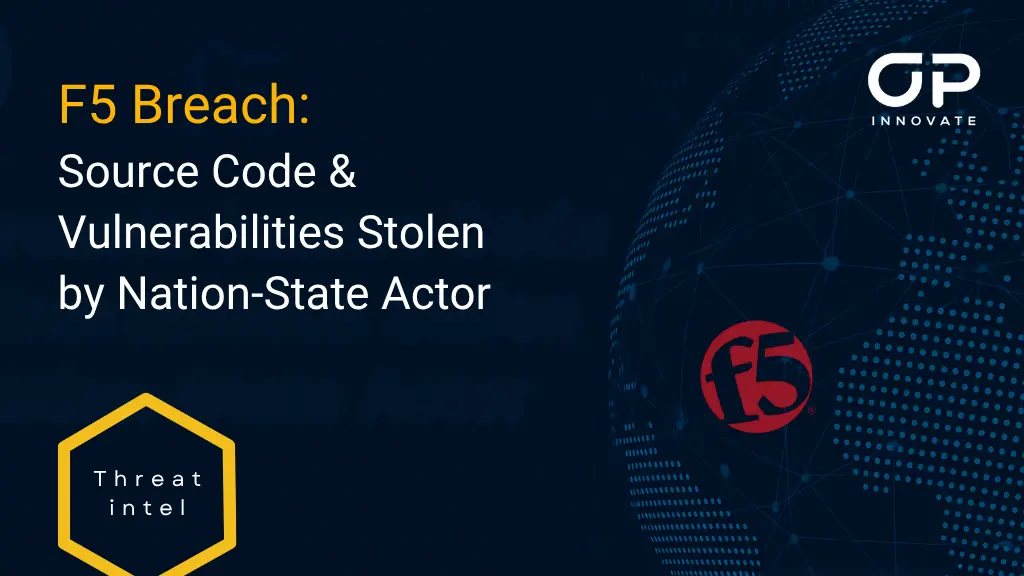In August 2025, U.S. cybersecurity vendor F5 Networks uncovered a long-term intrusion by a nation-state-linked threat actor that compromised its BIG-IP product development and engineering knowledge systems.
The attackers exfiltrated portions of BIG-IP source code, undisclosed vulnerability information, and limited customer configuration data.
Although F5 reports no evidence of software-supply-chain tampering or active exploitation, the breach gives adversaries an inside view of one of the world’s most widely deployed network-edge platforms.
Following public disclosure on October 15th, the Cybersecurity and Infrastructure Security Agency (CISA) issued Emergency Directive 26-01, warning that the compromise presents an imminent threat to organizations using F5 devices.
Attack Details
Discovery & Timeline
- Aug 9 2025: Intrusion detected in F5’s internal development network.
- Sept 12 2025: Disclosure delayed at the U.S. Department of Justice’s request for national security reasons (SEC Item 1.05 filing).
- Oct 15 2025: Public advisory and SEC 8-K filed; updates and customer guidance issued.
Scope of Compromise
The breach resulted in the exfiltration of proprietary BIG-IP source code, internal vulnerability research, and configuration data from a limited number of customer environments. F5 has not disclosed which vulnerabilities were included in the exfiltrated data.
The stolen material contained research into issues under active patch development. While F5 reassured these were not critical RCEs, the incident granted threat actors insight into BIG-IP’s internal code paths, potentially accelerating future zero-day discovery and exploit development.
There is no evidence that other F5 products, such as NGINX, Silverline, or F5 Distributed Cloud, were affected. Likewise, CRM, financial, iHealth, and support systems remain uncompromised.
F5 confirmed that its build pipelines, code-signing infrastructure, and released binaries were not tampered with. Independent audits by NCC Group and IOActive confirmed software integrity.
Attribution
Open-source reporting and forensic indicators tie the operation to a China-nexus espionage group (UNC5221) using the BRICKSTORM backdoor. The group has previously targeted SaaS and tech providers to steal source code for zero-day development.
For a list of TTPs and IOCs previously observed from this threat actor, see Mandiant’s Ivanti Connect Secure analysis (April 2025). It’s from a separate campaign but may contain useful indicators for threat hunting.
F5 CVE Disclosure
F5’s October 2025 Quarterly Security Notification, published 1–2 days prior to the public breach disclosure, listed more than 30 newly patched vulnerabilities across BIG-IP and F5OS.
While F5 has not linked these CVEs directly to the intrusion, the close timing suggests the company expedited coordinated patch releases to mitigate any potential overlap with data exposed during the compromise.
Some notable ones include:
CVE-2025-53868 (BIG-IP SCP and SFTP vulnerability) – CVSS 8.7 (v3.1)
A flaw in the Secure Copy (SCP) and SFTP subsystems of BIG-IP could allow unauthorized file access or command execution under certain configurations. Exploitation might enable lateral movement or data exfiltration in environments using default credentials or misconfigured access controls.
CVE-2025-61955 (F5OS privilege escalation vulnerability) – CVSS 8.8 (v3.1)
A vulnerability in the F5OS-A and F5OS-C appliance modes allows attackers to escalate privileges through improper validation of service permissions. This issue affects the underlying operating system used by BIG-IP Next and VELOS platforms, potentially broadening attacker reach beyond application services.
CVE-2025-60016 (BIG-IP SSL/TLS vulnerability) – CVSS 8.7 (v4.0)
A weakness in SSL/TLS session handling could expose sensitive session data or enable targeted man-in-the-middle attacks under certain conditions. Given the widespread use of BIG-IP in SSL offloading and traffic inspection, this flaw poses a high-impact risk for enterprises relying on encrypted traffic management.
For the complete list of vulnerabilities, please refer to F5’s Quarterly Security Notification (October 2025).
Threat Impact
The F5 intrusion is one of the most significant software-supply-chain breaches of 2025, not because of the strategic intelligence the attackers gained. Access to source code and unreleased vulnerability data offers an opportunity for adversaries to reverse-engineer critical components, identify unpatched flaws, and weaponize them before they are discovered by defenders.
Given F5’s widespread presence across enterprise, telecom, and government networks, any compromise of its product knowledge base creates systemic risk.
Organizations that rely heavily on F5 appliances for traffic management, SSL offloading, or network segmentation should assume potential reconnaissance activity and increased scanning in the coming months.
Mitigation & Response Guidance
1. Apply All F5 Updates Immediately
Install the latest releases for BIG-IP, F5OS, BIG-IP Next for Kubernetes, BIG-IQ, and APM clients as detailed in F5’s October 2025 Quarterly Security Notification.
These updates include hardening measures against any risk stemming from this breach.
2. Verify Software Integrity
Validate cryptographic signatures and checksums of all F5 software images. F5 rotated its signing certificates and keys on October 13, 2025. Older versions should be considered lower trust.
3. Restrict Management Interface Exposure
Ensure that no BIG-IP management interfaces are publicly accessible. Follow CISA’s ED 26-01 and BOD 23-02 guidance for isolating management networks behind VPN or jump hosts.
4. Implement Threat Hunting and Logging Enhancements
Enable BIG-IP event streaming to your SIEM or remote syslog. Monitor for unusual authentication attempts, configuration changes, or privilege escalations. Use F5’s new iHealth Diagnostic Tool for automated security gap detection.
Additionally, you can hunt for indicators and TTPs related to UNC5221, which is linked to the BRICKSTORM malware and the SPAWN ecosystem seen in other China-nexus campaigns.
5. Harden and Monitor End-of-Support Devices
Disconnect or segment any end-of-support F5 hardware. If decommissioning is not immediately possible, document exceptions and apply compensating controls such as network isolation and strict access policies.
If you need assistance assessing your exposure or implementing mitigations, please contact OP Innovate for tailored guidance.
Stay Safe. Stay Secure.
OP Innovate Research Team.



